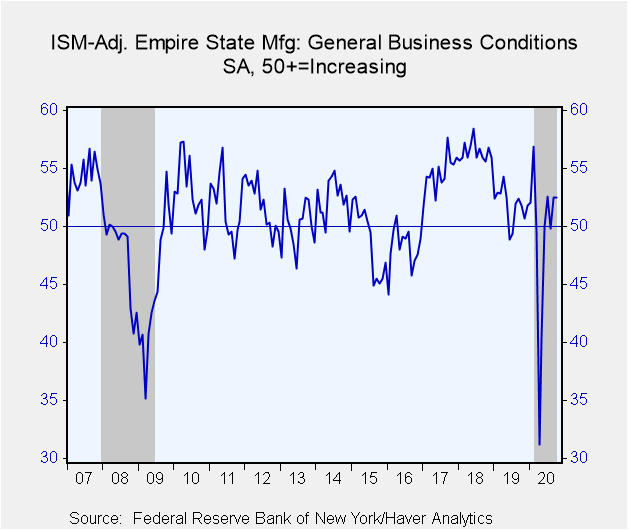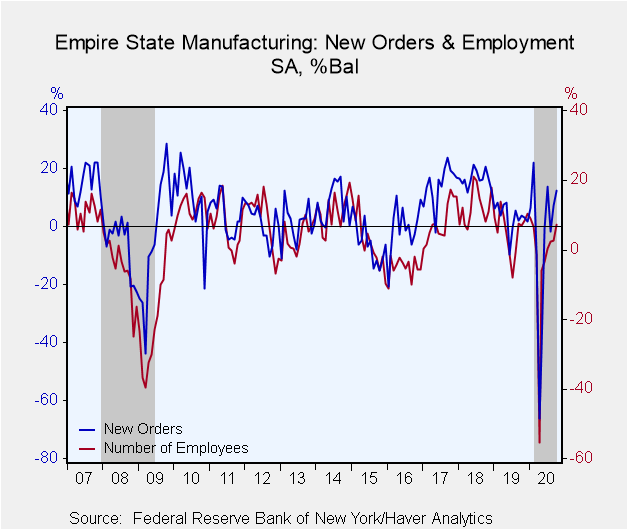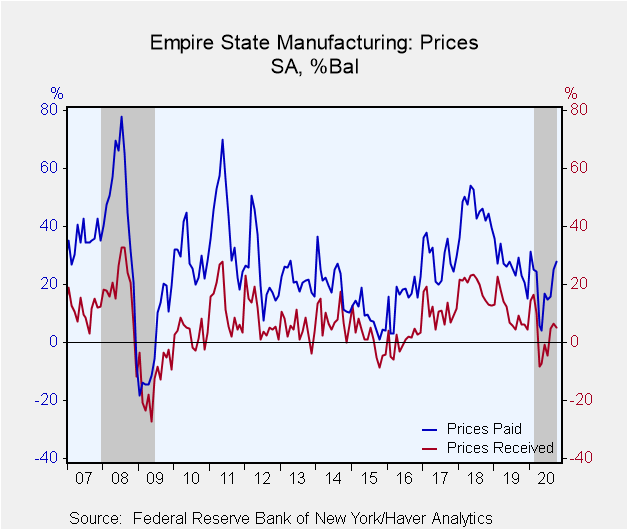 Global| Oct 15 2020
Global| Oct 15 2020Empire State Manufacturing Slows in October
by:Sandy Batten
|in:Economy in Brief
Summary
Economic activity in New York slowed more than the markets had expected in October with the Empire State General Business Conditions Index slipping to 10.5 after having jumped up to 17.0 in September. This was the fourth consecutive [...]
Economic activity in New York slowed more than the markets had expected in October with the Empire State General Business Conditions Index slipping to 10.5 after having jumped up to 17.0 in September. This was the fourth consecutive positive reading. The Action Economics Forecast Survey had looked for a modest decline to 15.0. Of respondents, 35.8% reported increased business conditions in October, down from 39.8% in September, while 25.3% reported a decline, up from 22.8% in September. The overall measure is a diffusion index which is constructed by subtracting the percentage decrease from the percentage increase and measures the breadth of change in manufacturing activity across the state.
Note that the headline index is constructed from the answer to a single question on business conditions. It is not constructed from the underlying indexes as is the purchasing managers' index. Haver Analytics calculates an ISM-Adjusted Index which mimics the construction of the purchasing managers' index. This figure rose was unchanged at 52.5 in October, comfortably above the 50 level which separates expansion from contraction and indicating that the underlying indexes were generally stronger than the headline.
The key underlying indexes were mixed in October with three strengthening and two weakening. The new orders index rose to 12.3 in October from 7.1 in September. The shipments measure increased to 17.8 from 14.1 in September. Unfilled orders remained in negative territory but rose to -6.6 in October from -9.4 the previous month. In contrast, delivery times shortened and inventories fell in October.
The employment indicators were clearly positive. The number of employees index rose to 7.2, its highest reading since January, from 2.6 in September. On an even more positive note, the average workweek index jumped up to 16.1 in October, its highest reading since May 2011, from 6.7 in September.
The prices paid index rose again--to 27.8 in October from 25.2 in September, pointing to a pickup in input prices. The prices received index posted another positive reading in September but slipped to 5.3 in October from 6.5 in September, likely indicating that the disinflationary pressures from the lockdowns continue to wane, though more slowly than in September. The rises in August, September and October followed four consecutive monthly declines.
Optimism about the future slowed in October but remained decidedly positive. The index of general business conditions expected in six months fell to 32.8 from 40.3 in September. Expectations for new orders, shipments and capital expenditures each fell slightly in October.
The Empire State figures are diffusion indexes, which are calculated by subtracting the percentage of respondents reporting declines from the percentage reporting gains. Their values range from -100 to +100. The data are available in Haver's SURVEYS database. The ISM-adjusted headline index dates back to July 2001. The Action Economics Forecasts can be found in Haver's AS1REPNA database.
| Empire State Manufacturing Survey | Oct | Sep | Aug | Oct'19 | 2019 | 2018 | 2017 |
|---|---|---|---|---|---|---|---|
| General Business Conditions (Diffusion Index, %, SA) | 10.5 | 17.0 | 3.7 | 3.3 | 4.8 | 19.7 | 16.1 |
| General Business Conditions Index (ISM Adjusted, >50=Increasing Activity, SA) | 52.5 | 52.5 | 49.8 | 51.8 | 51.8 | 56.4 | 54.6 |
| New Orders | 12.3 | 7.1 | -1.7 | 3.7 | 3.3 | 16.4 | 14.4 |
| Shipments | 17.8 | 14.1 | 6.7 | 10.5 | 10.5 | 20.3 | 15.8 |
| Unfilled Orders | -6.6 | -9.4 | -14.0 | -12.5 | -6.0 | 3.5 | 1.9 |
| Delivery Time | 2.0 | 5.0 | 1.3 | -2.5 | -0.1 | 9.1 | 6.1 |
| Inventories | -14.6 | -3.6 | -10.7 | -0.6 | -0.9 | 5.9 | 1.5 |
| Number of Employees | 7.2 | 2.6 | 2.4 | 6.9 | 5.4 | 12.3 | 8.0 |
| Average Employee Workweek | 16.1 | 6.7 | -6.8 | 7.0 | 2.3 | 7.8 | 4.6 |
| Prices Paid | 27.8 | 25.2 | 16.0 | 23.1 | 26.3 | 45.8 | 29.0 |
| Prices Received | 5.3 | 6.5 | 4.7 | 6.3 | 10.3 | 19.3 | 11.0 |
| Expectations 6 Months Ahead | 32.8 | 40.3 | 34.3 | 17.8 | 23.9 | 35.2 | 42.6 |
Sandy Batten
AuthorMore in Author Profile »Sandy Batten has more than 30 years of experience analyzing industrial economies and financial markets and a wide range of experience across the financial services sector, government, and academia. Before joining Haver Analytics, Sandy was a Vice President and Senior Economist at Citibank; Senior Credit Market Analyst at CDC Investment Management, Managing Director at Bear Stearns, and Executive Director at JPMorgan. In 2008, Sandy was named the most accurate US forecaster by the National Association for Business Economics. He is a member of the New York Forecasters Club, NABE, and the American Economic Association. Prior to his time in the financial services sector, Sandy was a Research Officer at the Federal Reserve Bank of St. Louis, Senior Staff Economist on the President’s Council of Economic Advisors, Deputy Assistant Secretary for Economic Policy at the US Treasury, and Economist at the International Monetary Fund. Sandy has taught economics at St. Louis University, Denison University, and Muskingun College. He has published numerous peer-reviewed articles in a wide range of academic publications. He has a B.A. in economics from the University of Richmond and a M.A. and Ph.D. in economics from The Ohio State University.










